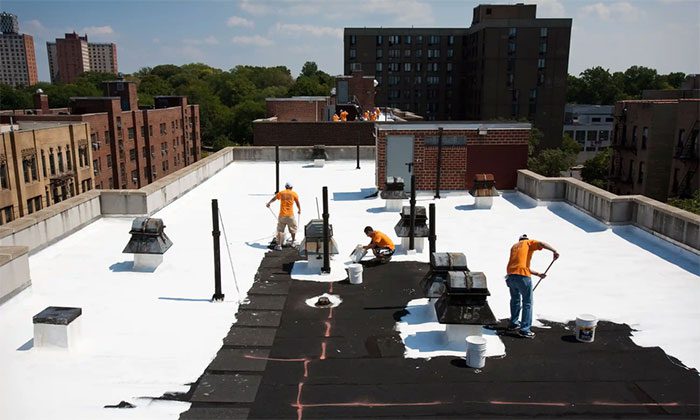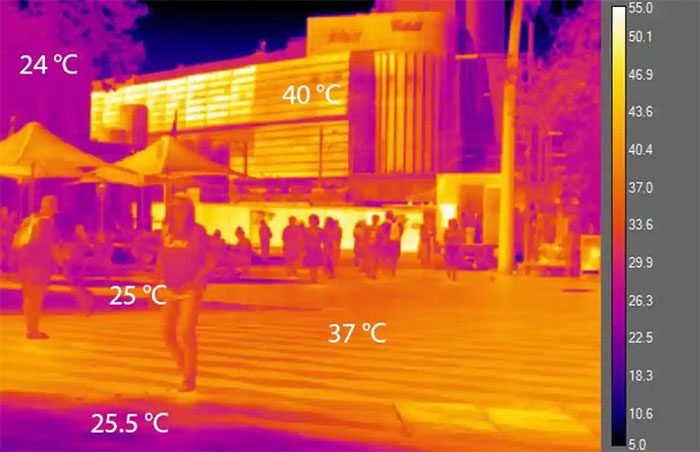Using light-colored coatings for roofs or pavements can significantly reduce the urban heat island effect during the summer, making temperatures in cities cooler.
When many city dwellers feel uncomfortable and hot during the summer, the Guardian suggests that the cause may not solely be the weather. The artificial environment is exacerbating high temperatures in any urban center.
Transportation vehicles are emitting heat in congested areas. Air conditioning units are releasing exhaust into the atmosphere. Concrete and asphalt dominate most surfaces, absorbing and radiating sunlight…

Applying a white coating to rooftops can help reduce heat absorption. (Photo: Guardian).
All of these factors contribute to the urban heat island effect, causing city temperatures to be as much as 10 degrees Celsius higher than those in nearby rural areas.
If we want cities to be cooler, changing building materials is essential. Dark, hard materials—concrete, asphalt, and paving stones—currently dominate urban environments, and most of them absorb rather than reflect sunlight.
Increasing the reflectivity (albedo) of building surfaces and pavements will help mitigate the urban heat island effect. On a typical sunny day, about 1 kW/m² of solar radiation hits roof surfaces. Between 20-95% of this radiation is absorbed, depending on the different roof colors, according to the Conversation.
Lowering Temperatures
A research center in Australia reported that conventional pavement can reach temperatures of up to 67 degrees Celsius, while conventional rooftops can soar to 60-90 degrees Celsius on a hot day.
Such temperatures can have significant health impacts. According to expert Arthur Rosenfeld from the Lawrence Berkeley National Laboratory, living on the top floor of a building with a dark-colored roof was identified as a risk factor for mortality during the 1995 heat wave in Chicago (USA).
“The government has a responsibility to ban or phase out the use of black or dark roofs, at least in warm climate regions, as they pose significant health risks,” he stated.
The Guardian suggests that the best remedy is to use reflective thermal coatings—typically lighter pigments in asphalt or white coatings for roads, roofs, and facades. These will help cities reflect more solar energy.

A thermal image of Sydney shows high surface temperatures of asphalt and buildings, while temperatures in the shade are lower. (Photo: Guardian).
For example, according to the Cool Roof Initiative in New York, over 500,000 m2 of rooftop space has been coated with reflective white surfaces, helping to reduce approximately 2,282 tons of CO2 emissions each year from cooling-related emissions.
In this city, reflective roofs are installed for free on public buildings, non-profit organizations, and affordable housing. In other buildings, owners only need to pay for materials, with no labor fees for installation.
This measure is quite simple but yields significant results. According to NASA research, white roofs can be up to 23 degrees Celsius cooler than typical black roofs on the hottest days of the year.
The Cost Question
In Los Angeles, it’s not the roofs but the roads that pose a challenge in the summer. More than 10% of the city’s land area is covered in black asphalt, absorbing up to 95% of solar energy, contributing to the “urban heat island effect.”
And as these roads become scorching hot, the surrounding heat radiates into nearby residential areas. This leads to discomfort and affects residents’ health. Additionally, it causes a spike in energy consumption, as all those fans and air conditioning units are cranked up to maximum cooling.
To tackle this issue, the city has been painting roads with a high-reflectivity white sealant, costing $40,000 per mile (approximately 1.6 km). Initial measurements show that temperatures have dropped after the painting.

Workers apply reflective sealant to roads in Los Angeles in May 2017. (Photo: Los Angeles Street Services).
CBS Los Angeles explains that dark asphalt can quickly heat up as temperatures rise, absorbing 80-95% of sunlight. On sweltering summer days when temperatures can reach 38 degrees Celsius, the pavement temperature in Los Angeles can exceed that by up to 10 degrees Celsius. Furthermore, this coating has a lifespan of only about seven years.
However, supporters believe that advancements in asphalt technology will lower costs. Additionally, TreeHugger points out that there are economic benefits involved: “Residents in neighborhoods with white-coated roads are less likely to run their air conditioning at full blast, helping to reduce energy bills and emissions.”
Moreover, the high reflectivity of the white-coated asphalt means that street lighting systems don’t need to be turned on prematurely in the evening, further saving energy.
Public health will also improve, especially during dangerous heat waves that could worsen due to heat emitted from asphalt.
A high solar reflectance (or albedo) is the most important characteristic of cool roofs, as it helps reflect sunlight and heat away from buildings.
A high thermal emittance also contributes to cooling, particularly in warm and sunny climates. These properties allow roofs to absorb less heat and remain cooler by up to 28-33 degrees Celsius compared to conventional materials during peak summer weather, according to the U.S. Environmental Protection Agency.



















































